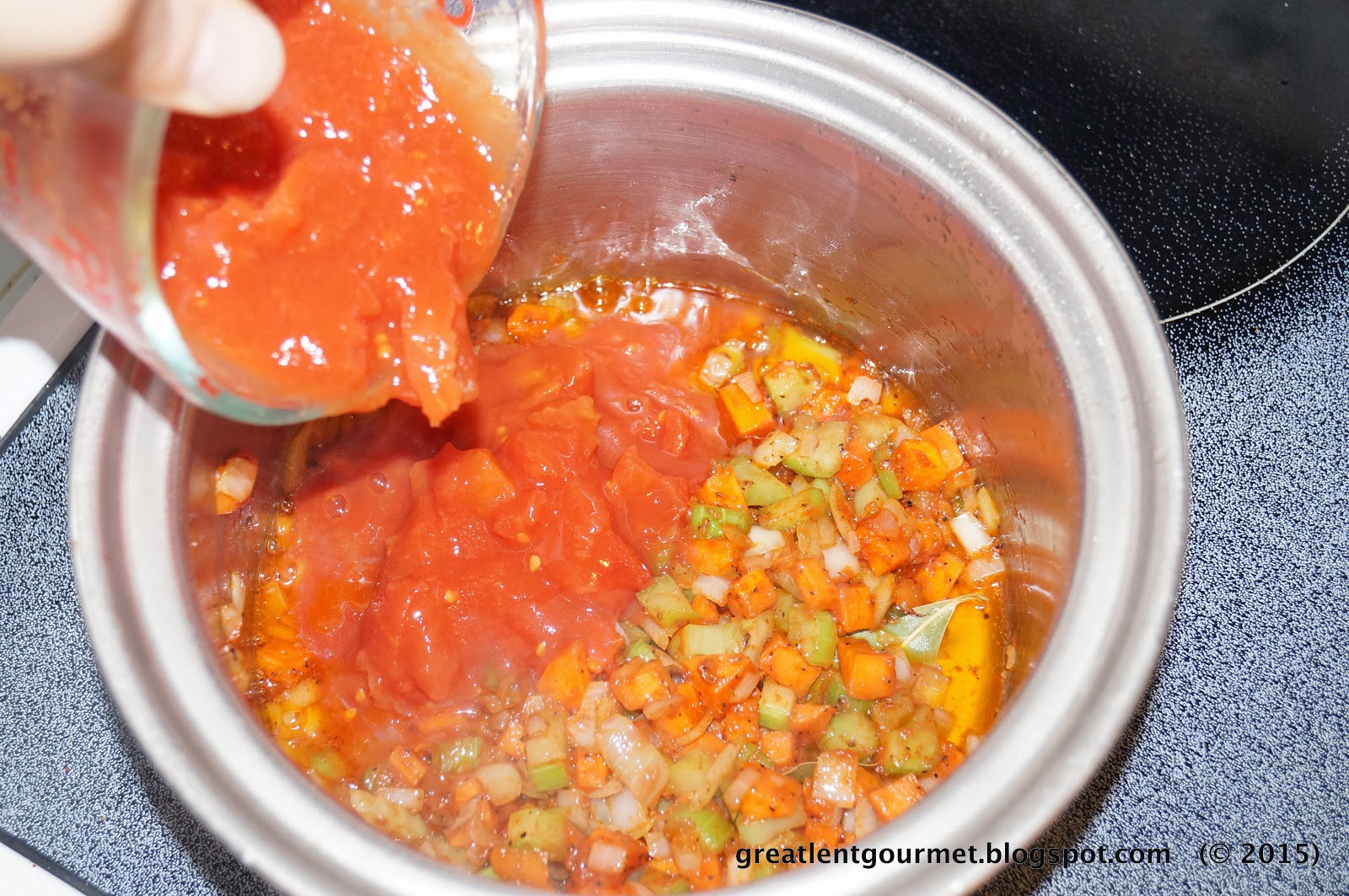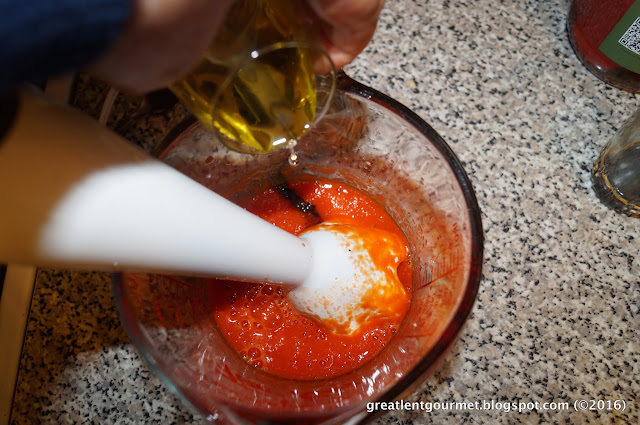Fasolada is something that my mother in law makes regularly. She often sends a container over to our house to make sure that we get some. On occasion, when we are visiting with the parents, she will heat some soup for us all, just like some people would serve coffee. It is endearing and generous. The nicest part about being served soup when visiting, is that you don’t have to go through the work to make it for yourself at home. But, today, we did.
The real work comes in taking the time to cut up all the ingredients. With Fasolada, there are only a few ingredients to prepare, and then it is a matter of the time needed for the soup to simmer to perfection. And, regardless of what time of year it is – Great Lent, Winter, Autumn, or whenever, having a bowl of Fasolada is comforting and warming.
Surprisingly, Greek bean soup - also known as fasolada (or fasolatha) is considered by many the national dish of Greece. It is a very flavourful and highly nutritious dish that is very inexpensive to make. In fact, most Greek homes will have fosolada at least once a week as the main meal (usually Wednesday or Friday) with some bread, olives and a green (such as dandelion greens with oil and lemon).
Surprisingly, Greek bean soup - also known as fasolada (or fasolatha) is considered by many the national dish of Greece. It is a very flavourful and highly nutritious dish that is very inexpensive to make. In fact, most Greek homes will have fosolada at least once a week as the main meal (usually Wednesday or Friday) with some bread, olives and a green (such as dandelion greens with oil and lemon).
We started to make this with a phone call asking my mother in law how she makes hers. Husband loves his mother’s Fasolada, so why not learn from “the master” of the soup? We called and asked for directions. Of course, in the expected Greek Mother way, we were told, “Oh, come over, I will make you some.” And, even though that was not the purpose, we did. We went, we ate, we chatted, and we were given verbal directions, complete with hand gestures and a container full of soup to go!
What we needed to do was decide how much “some”, “a little”, and “a handful” meant this time, and as we did, we realized that everyone will define these amounts differently, and they are negotiable when making Fasolada, so we are giving you the basic amounts to serve 4 people.
For this recipe, you will need the following:
1 can white beans or ½ pound dried (soaked, rinsed, and boiled)
½ cup oil
1 onion
1 carrot
1 celery stalk
1 bay leaf (we used a large Greek bay leaf, as shown above)
7-8 oz (about 225 g) diced tomatoes with liquid
1 TBSP tomato paste
salt and pepper to taste
First, cut up all your vegetables and drain and rinse the canned beans. If you are using the dried beans, they would have been soaked overnight and you should have boiled them for about 30-45 minutes to make them mostly soft. Assuming that the beans are ready, we are starting with the vegetables.
We chopped one onion, one carrot, and one stalk of celery. Often on cooking shows, you will hear this combination referred to as “The Holy Trinity”. That may seem fitting, since in Orthodoxy we do many things for the Holy Trinity, but it may also seem offensive, depending on your opinion. The combination of diced onion, diced carrot, and diced celery is called Mirepoix (pronounced meer-pwah). It is a French term that basically means a mixture.
Have all your ingredients ready to go, since once you start cooking the vegetables, things move along through the process rather quickly. The longest part of the process will be at the end, waiting to eat!
Start the cooking with heating some oil in the pot. You need enough oil to coat the bottom of the pot. Bring the oil to a hot temperature, but not smoking hot.
Put the mirepoix in the pot. You can put them all at once, or one at a time. We did one at a time to show for pictures, but we were told that you just put everything in the pot at once and turn it on, and you get Fasolada.
Cook the vegetables long enough to make them soft. This should take about fifteen minutes. You can check the softness by tasting them or feeling them. Just make sure that they are soft without being mushy. Season with some salt and pepper. Then, add the tomato paste. When you put the paste in the pot, make sure it coats all of the vegetables, and allow the tomato paste to cook for a few minutes. We found that by allowing the paste to cook, we got a more rich and deep tomato flavor in the end.
Then, add the diced tomatoes. Add the bay leaf, too. We use a Greek Bay Leaf, which we will discuss on another day. It is much more flavourful than the small non-Greek ones. My mother-in-law tells me that she sometimes uses crushed tomatoes in a can, or she will get the tomatoes that have been put in the freezer from the summer garden, and she will spend her time to grate the frozen tomatoes for this recipe. The tomatoes from the garden do give the soup a different taste, and if I knew how to spell my mother-in-law's description, I would; but I can tell you that it is similar to, "Yummm."
Now, add the beans and the water. You will have to judge how much water to add by how your soup looks. You want to add enough to make it soupy, but not enough to cancel out the tomato flavor. We added about two and a half cups of water to our pot. As it was explained to us, “You know, Fasolada is soup. You make it like soup.”
Now, let this mixture simmer on the stove. Depending on your beans and how long you cooked the vegetables, this should simmer between 30 and 60 minutes. Oh, and as my mother-in-law tells us, “You know it is done when it tastes just right!” It is such a joy and a gift to be given directions like this.
Serve the fasolada with some crusty bread, red wine vinegar, and maybe some olives. A few dashes of the red wine vinegar provides a nice flavour accent to the fasolada. That’s how they eat it in Greece, and that is how we eat it with the family. Either way, it is a comfort food that warms every home and every heart.
* A note: When we sat down to eat this today, husband and I agreed that this recipe was not exactly like my mother-in-law's. According to husband, another can of beans to the recipe could have made the soup more like his mother's. He did, however, give two thumbs up for the dish described in this post as "Absolutely delicious!"
A certain monk told me that when he was very sick, his mother said to his father, "How our little boy is suffering. I would gladly give myself to be cut up into pieces if that would ease his suffering." Such is the love of God for people. He pitied people so much that he wanted to suffer for them, like their own mother, and even more. But no one can understand this great love without the grace of the Holy Spirit.
A certain monk told me that when he was very sick, his mother said to his father, "How our little boy is suffering. I would gladly give myself to be cut up into pieces if that would ease his suffering." Such is the love of God for people. He pitied people so much that he wanted to suffer for them, like their own mother, and even more. But no one can understand this great love without the grace of the Holy Spirit.
(St. Silouan the Athonite, Writings, IX.10)
Source of quote: http://orthodox.cn/patristics/300sayings_en.htm






















































